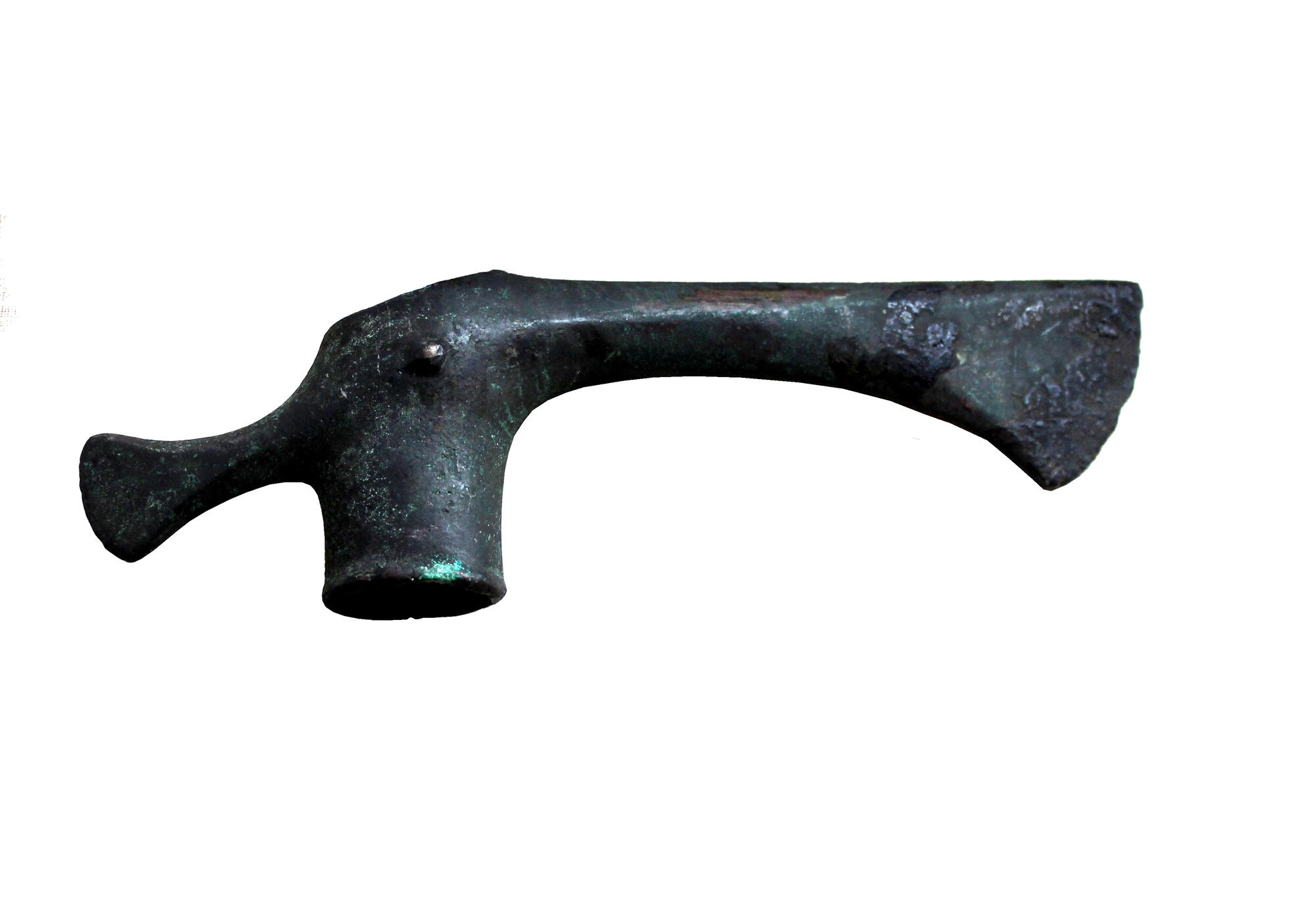The Museum of Local History and Lore has a unique exhibit: a bronze socketed axe. It was found by P. Gulyaev, a resident of the town of Oktyabrsk, on the right bank of the Volga. He donated his find to the museum in 1981.
The axe is of the so-called Vladimirsky type: it has got a hammer, a relief ornament, and a long and narrow wedge perpendicular to the butt. The strongest axis goes down the center of the blade, then through the socket and into the hammer. The blade is a regular rhomboid in cross-section while the cutting edge is slanted downward and gets wider toward the beard.
The socket looks like a long narrow tube, and in the middle of its back is the hammer. The hole in the socket is round at the bottom and an elongated oval at the top. There is no pronounced slant of the back over the socket. The relief ornament on both sides of the socket has the shape of cast cones from which rollers extend in both sides, morphing into the strongest section of the blade. The lower edge of the bushing is framed with a roller.
A total of three axes of this type have been found along the Volga, and six more have been found beyond the Urals. What sets this type of axe apart is that they were used as both weapons and scepters. These axes were used in a relatively short historical period coinciding with the emergence of the late Bronze Age cultures in the region between the Volga and the Ural in the first quarter of the 2nd millennium BC.
The Vladimirsky type axes with a protrusion on the socket probably originated in the Sintashta culture. The chieftains of the Sintashta tribes were warriors and that role reflected in their symbols of power, the scepters: they simply used their battle axes in that capacity. The weapon found in Oktyabrsk is a late version of this type of axe. The find is exceptional but somewhat predictable too because it belongs to a short but eventful period of the bronze age in Eurasia. The area around Syzran along the Volga River was one of the principal locations of the major developments of that era.
The axe is of the so-called Vladimirsky type: it has got a hammer, a relief ornament, and a long and narrow wedge perpendicular to the butt. The strongest axis goes down the center of the blade, then through the socket and into the hammer. The blade is a regular rhomboid in cross-section while the cutting edge is slanted downward and gets wider toward the beard.
The socket looks like a long narrow tube, and in the middle of its back is the hammer. The hole in the socket is round at the bottom and an elongated oval at the top. There is no pronounced slant of the back over the socket. The relief ornament on both sides of the socket has the shape of cast cones from which rollers extend in both sides, morphing into the strongest section of the blade. The lower edge of the bushing is framed with a roller.
A total of three axes of this type have been found along the Volga, and six more have been found beyond the Urals. What sets this type of axe apart is that they were used as both weapons and scepters. These axes were used in a relatively short historical period coinciding with the emergence of the late Bronze Age cultures in the region between the Volga and the Ural in the first quarter of the 2nd millennium BC.
The Vladimirsky type axes with a protrusion on the socket probably originated in the Sintashta culture. The chieftains of the Sintashta tribes were warriors and that role reflected in their symbols of power, the scepters: they simply used their battle axes in that capacity. The weapon found in Oktyabrsk is a late version of this type of axe. The find is exceptional but somewhat predictable too because it belongs to a short but eventful period of the bronze age in Eurasia. The area around Syzran along the Volga River was one of the principal locations of the major developments of that era.














